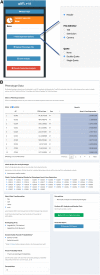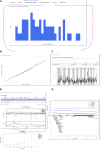gQTL: A Web Application for QTL Analysis Using the Collaborative Cross Mouse Genetic Reference Population
- PMID: 29880557
- PMCID: PMC6071593
- DOI: 10.1534/g3.118.200230
gQTL: A Web Application for QTL Analysis Using the Collaborative Cross Mouse Genetic Reference Population
Abstract
Multi-parental recombinant inbred populations, such as the Collaborative Cross (CC) mouse genetic reference population, are increasingly being used for analysis of quantitative trait loci (QTL). However specialized analytic software for these complex populations is typically built in R that works only on command-line, which limits the utility of these powerful resources for many users. To overcome analytic limitations, we developed gQTL, a web accessible, simple graphical user interface application based on the DOQTL platform in R to perform QTL mapping using data from CC mice.
Keywords: collaborative cross; qtl; software.
Copyright © 2018 Konganti et al.
Figures


Similar articles
-
Quantitative trait locus analysis using J/qtl.Methods Mol Biol. 2009;573:175-88. doi: 10.1007/978-1-60761-247-6_10. Methods Mol Biol. 2009. PMID: 19763928 Review.
-
Complex Trait Analyses of the Collaborative Cross: Tools and Databases.Methods Mol Biol. 2017;1488:121-129. doi: 10.1007/978-1-4939-6427-7_5. Methods Mol Biol. 2017. PMID: 27933522
-
Designing a QTL Mapping Study for Implementation in the Realized Collaborative Cross Genetic Reference Population.Curr Protoc Mouse Biol. 2019 Dec;9(4):e66. doi: 10.1002/cpmo.66. Curr Protoc Mouse Biol. 2019. PMID: 31756057
-
Which mouse multiparental population is right for your study? The Collaborative Cross inbred strains, their F1 hybrids, or the Diversity Outbred population.G3 (Bethesda). 2023 Apr 11;13(4):jkad027. doi: 10.1093/g3journal/jkad027. G3 (Bethesda). 2023. PMID: 36735601 Free PMC article.
-
QTL mapping in intercross and backcross populations.Methods Mol Biol. 2009;573:157-73. doi: 10.1007/978-1-60761-247-6_9. Methods Mol Biol. 2009. PMID: 19763927 Review.
Cited by
-
Refining risk estimates for lead in drinking water based on the impact of genetics and diet on blood lead levels using the Collaborative Cross mouse population.Toxicol Sci. 2023 Jul 28;194(2):226-234. doi: 10.1093/toxsci/kfad054. Toxicol Sci. 2023. PMID: 37243727 Free PMC article.
-
Diverse tumour susceptibility in Collaborative Cross mice: identification of a new mouse model for human gastric tumourigenesis.Gut. 2019 Nov;68(11):1942-1952. doi: 10.1136/gutjnl-2018-316691. Epub 2019 Mar 6. Gut. 2019. PMID: 30842212 Free PMC article.
-
Baseline Gait and Motor Function Predict Long-Term Severity of Neurological Outcomes of Viral Infection.Int J Mol Sci. 2023 Feb 2;24(3):2843. doi: 10.3390/ijms24032843. Int J Mol Sci. 2023. PMID: 36769167 Free PMC article.
-
QTLViewer: an interactive webtool for genetic analysis in the Collaborative Cross and Diversity Outbred mouse populations.G3 (Bethesda). 2022 Jul 29;12(8):jkac146. doi: 10.1093/g3journal/jkac146. G3 (Bethesda). 2022. PMID: 35703938 Free PMC article.
-
Viral Clearance and Neuroinflammation in Acute TMEV Infection Vary by Host Genetic Background.Int J Mol Sci. 2022 Sep 9;23(18):10482. doi: 10.3390/ijms231810482. Int J Mol Sci. 2022. PMID: 36142395 Free PMC article.
References
-
- Chang, W., J. Cheng, J. Allaire, Y. Xie and J. McPherson, 2016 shiny: Web application framework for R, http://shiny.rstudio.com.
Publication types
MeSH terms
Grants and funding
LinkOut - more resources
Full Text Sources
Other Literature Sources
Molecular Biology Databases
